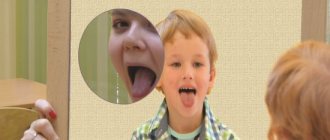- home
- Correction
Logoneurosis, or stuttering during speech, is a pathological condition in which a child or adult repeats or prolongs sounds, syllables and words.
Articulation in logoneurosis is accompanied by convulsions of the organs of the speech apparatus or long stops when moving from one sound to another. Symptoms of stuttering appear at an early age if their basis lies in a genetic predisposition to pathology, in congenital diseases of the central nervous system; at any period of life, if the cause of the disease is stress, fear, psychological trauma.
Stuttering is divided into neurotic and neurosis-like. The first are treated therapeutically: breathing exercises, hypnosis, psychological and speech therapy assistance to the child. Special attention should be paid to the atmosphere in the family, relaxation, sports, and singing. The second, neurosis-like, require the use of antispasmodics, tranquilizers, several courses of dehydration, massage and physiotherapy.
Breathing exercises are useful for the treatment of any type of stuttering, as well as its prevention at an early age in children. If you perform the exercises in strict sequence, according to instructions and regularly, then in 70% of cases the prognosis for the recovery of preschool and school-age children is favorable.
Physiological features of stuttering
What is the basis of the physiology of stuttering? The disorder is characterized by the following manifestations:
- muscle spasms occur in organs involved in articulation, for example, in the larynx, lips, pectoral and diaphragmatic muscles;
- the face acquires an expression of strong tension and stiffness;
- the muscles of the mouth are convulsively tense and trembling;
- due to muscle tremors and spasms, individual letters or syllables cannot move into the next ones, words lengthen, and “get stuck” in the same place.
A person with a stutter begins to get nervous, worried, and upset. Therefore, such people are often characterized by increased emotionality and imbalance.
VOICE PRODUCTION USING A.N. STRELNIKOVA’S METHOD
Singing is one of the ways of human communication and self-expression, accessible to almost everyone. Therefore, this action is natural and simple. Someone who is a natural singer wants to sing, just like someone who is a natural runner wants to run. The singer’s body establishes connections necessary specifically for singing - easier than any others, and requires their use, because in living nature, what is not used dies. Singing satisfies not only the aesthetic and emotional, but also the physical need of a person, which the singer needs to know and remember. This is the work of a complex of muscles associated with the breathing process, and unconsciously organized by a creative emotional mood. Complex work is impossible without a coordinating center, and since it is organized by emotion, a professional must be able to create it and maintain it while singing. In people who sing with voices that we call “naturally set,” sound connections are established unconsciously, but at the same time correctly and easily, breathing is organized correctly. In such cases, the only thing the teacher must do is to help the singer realize what is happening in his beautiful instrument while singing, so that he can preserve his voice and restore natural connections if accidents disrupt them. But, singing schools in most cases propose to perceive singing not as a way of expressing thoughts and feelings, but as a means for mentally directing the sound on each note. By worrying about the note, the singer loses his natural sense of the cantilena and a meaningful phrase and thinks not about who, why and why he is singing, but about whether the given note hit where he intended it. Passion for singing causes an unconscious desire for synthesis, that is, for the unification of the muscles involved in it, for the organization of a coordinating center. Analyzing your feelings while singing weakens and disrupts the connections of sound science. Sometimes the singer’s attention is focused on one muscle group: “Mask on!” In the mask!”, “On the teeth!”, “Into the dome!”. This is what disrupts the natural connections of sound science, and with them the feeling of a joyfully singing body that a person naturally has, just as a nightingale or a lark has it, is lost. The need for deep internal connections is in most cases realized by singers. They are created and preserved by the singing emotional mood, as long as it is not interfered with or not interfered with too actively. With rude interference, the connection is broken in some link, and the voice stops sounding. The loss of the voice is a violation of the connections of sound science, and its return is the restoration of these connections. What needs to be done to maintain and develop connections in sound science? The voice plays a melody. And melody is movement. Only that which is itself movable can produce movement. The ball flew, a hand threw it, the branch swayed, it was pushed by the wind. The respiratory organs, their muscles and the muscles associated with them are mobile. This is what can speak, shout and sing in a person! A singer's instrument is part of his body. And, moreover, one of the most important and least controllable is his respiratory organs. We do not see the movements that occur inside them, and these movements depend on the emotional state. Therefore, learning to sing means learning to control breathing and the singing emotional state. But, not only breathing is subordinated to emotions, but emotions can also be subordinated to breathing! Actors and singers have a professional term for "prop." A “propped” voice is a ringing voice. What is a “supported” breath? Touching your partner's shoulder does not mean leaning on him. To lean is to transfer part of the weight of your body onto someone else’s shoulder, to feel that the muscles of the shoulder have begun to resist the pressure of your hand. Therefore, a “supported” inhalation is an inhalation of extreme depth. The air taken during such an inhalation cannot go further. He “leaned”, that is, he simply rested against the walls of the respiratory organs. The muscles surrounding them begin to resist the pressure of the air, and you feel it. The sensation is similar to what you experience when leaning on someone else's shoulder: elastic, physically pleasant muscle resistance. And if the breath is taken correctly, you will immediately want to sing! Inhalation is the movement of air into the body. To consciously take a breath means to mentally establish a connection with the bottom of the lungs. The direction of the larynx is diagonal in relation to the lungs, therefore, it is more convenient to sing if you have taken a conscious or unconscious breath, “supported” in the back. The lungs expand to their bases not in the chest, but in the back. Consequently, this inhalation is easy to hold, although its volume is large. The sound is an exhalation that vibrates the vocal cords. In order to maintain a feeling of “support” while playing, you need to learn to hold a correctly taken breath. And one more thing: you don’t need to think about the path along which you will take your breath. Think about the place where he instantly comes, because if you think about the road, tension arises there. Lead your inhalation with movement and emotional attitude. Use the tilt as you inhale. Hold your breath and sing without directing the sound anywhere. There is an opinion that “blocking” breathing is harmful, almost dangerous. Yes, holding an inhale that distorts the shape of the lungs, and even just doing it, is harmful! An inhalation that fills the lungs without distorting their shape can restore both voice and health! The best voice production in the world is not Russian, not French, not German or even Italian... The best voice production in the world is NATURAL! If you consciously take the right breath and hold it, your singing intuition will do the rest. Remember the drill song in the army, the choir song at the table and the labor song, for example our “Dubinushka”. In all cases, the song lifts the mood, frees us from habitual restraint and unites people in a way that mere words without melody cannot unite. Wanting to express thoughts and feelings, people first of all look for words and sing them to music. For a person who sings naturally, SINGING IS LONG SPEECH OF HIGH EMOTIONALITY! And in professional singing, in pop, romance, operetta and even opera music, vocalization is an exception, most often on the upper notes, where pronouncing words is difficult. And there is no natural boundary between conversation and recitative, and recitative is the introduction to an aria. Consequently, it makes no sense for a professional singer to imagine singing as a vocalise with words, and even with voice production. After all, then it is an abstruse and complex action. And the words in this case only get in the way of singing. What is it like to listen to a singer whose words prevent him from singing? If for you singing is drawn-out speech, then this action is emotional and simple, and the words help to sing and organize the cantilena. You just need to be able to pronounce these words, because, as you know, “what is well spoken is half sung.” Music has three dimensions - pitch, timbre and force . The singer must simply help the vocal cords close so that the pitch of each note is accurate, and free the timbre from extraneous sounds. As for strength, you can’t think about it; forcing it won’t create it. You need to think about sonority—a sonorous voice flies well into the audience. As for the range, it is obvious that the abdominal muscles and diaphragm should actively work on the upper notes, and the pectoral muscles on the lower notes.
“LOSS” OF VOICE AND ITS RESTORATION All singers, Alexandra Nikolaevna and myself, patients who complained of a short range, weakness of sound, rapid fatigue from singing and talking, dryness and pain in the throat, singing or fibromatous nodules, had small clavicular or thoracic overextended and strained breathing. This was the main cause of the disease. The sound is an exhalation that vibrates the vocal cords. If there is too much air in the narrow tops of the lungs, it is cramped. And it tends to escape during the sound in such a wide stream that it prevents the vocal cords from closing. It puts pressure on the larynx from below so that it tends to push the larynx with closed vocal cords upward. A singer, actor, or even just a person who needs to speak or sing cannot remain silent. He continues speaking or singing on vocal cords that are not closed or are difficult to close and, of course, finishes his work sick. Goes to the doctor. And then in a circle: bulletins, medicines, advice to take care of your voice. And fear comes to the aid of the disease. The person begins to think intensely about the larynx and vocal cords, and they tense in response to his thoughts. A nodule begins to grow from incorrect sound guidance. Bulletins are increasingly frequent and lasting longer, and, if silence and medications do not help, surgical removal of the nodule is required. But no matter how wonderful the surgeon is, the improvement in well-being and sound is short-lived, because breathing and sound management remain incorrect. The nodule may reoccur. Again, prompt removal and, in most cases, an offer to change profession. Therefore, it is necessary not to protect the voice, but to organize breathing and sound management differently . The first thing I recommend to both actors and singers is to remove excess air from the upper lobes of the lungs and force them to practice the inhalation that is most convenient for holding. This creates an air reserve at the bases of the lungs and prevents excess air from entering the larynx. Singing and speaking immediately becomes easier. Then I give special sound exercises using the same movements that the singers used to inhale. The diaphragm and abdominal press actively work during the sound, and the pain or nodule begins to disappear. And when you have trained them to work in support of sound, they will work out of habit. A habit requires reinforcement. Breathing exercises must be repeated. Therefore, breathing exercises by A.N. Strelnikova MUST be done before each concert or opera performance. And here's another thing. If while singing you have an unpleasant sensation in some part of your body, know that there is a mistake there. Find a movement that will remove this feeling. We are told that singing well is difficult and difficult, and singing poorly is easy and simple. But in life, everything is the other way around: a bad singer sings difficult and difficult, while a good singer sings easily and naturally. Now you know why!
RECOMMENDATIONS FOR SINGERS AND DRAMATIC ACTORS Never think about breathing, either in singing or in speech. Think about the meaning of what you are saying or singing about. Spectators sitting in the front row of the stalls should not see how the singer uses his breath on stage. In order for the head register to sound good, so that the upper notes are ringing, it is necessary to create a so-called diaphragmatic “support” , i.e. very strong tension in the lower abdomen. Strelnikovsky breathing exercises will help develop the singing apparatus and create the so-called “column of sound”, which world-famous opera singers have from God.
RECOMMENDATIONS. Working with vocalists requires special, “filigree” skill, because the voice of each singer can ultimately become national pride. Mistakes are not allowed here. You should consider: 1. the type of voice of the singer (bass, baritone or tenor, coloratura soprano or contralto...); 2. his physical characteristics; 3. type of nervous system; 4. the condition of his spine (especially the cervicothoracic region); 5. general hormonal background of the body (it is well known that sex hormones affect the tone of the vocal folds)
REMEMBER! The voice should not only be clear and beautiful, but also durable!
How breathing exercises help
Systematic implementation of breathing exercises for stuttering leads to the following results:
- the relationship between the rhythm and tempo of spoken speech is restored;
- in the process of exercises, a person (child or adult) learns to independently control breathing, shape it during a conversation, regulating the volume of air entering the lungs;
- muscle tone of the abdominal wall increases;
- The muscles of the diaphragm are strengthened, diaphragmatic breathing is formed.
Over time, the person feels more confident and stops stuttering.
Treating stuttering with breathing exercises can take a long time (perhaps even years). However, regular, persistent exercise can eliminate even the most advanced disorder.
Execution Rules
In order for breathing exercises to have a therapeutic effect, you must follow some rules:
- Execution must be regular: at least twice a day. Each lesson takes about a quarter of an hour.
- Many breathing exercises can cause dizziness. If there is a tendency to such a disorder, you should practice while sitting, and in some cases it is allowed to lie down.
- Breathing is combined with movements. In this case, you need to move only while inhaling.
- The inhalation should be sharp, with noise, through the nostrils, and the exhalation should be calm, without noise or sounds, using the mouth.
- As a rule, at the very beginning of treatment, gymnastics is performed without pronouncing sounds and words. In the future, speech elements will be included in it. Each subsequent stage begins only after a person has completely mastered the previous one.
- When pronouncing sounds, be sure to monitor the muscle tone of the face - relax the muscles when tense.
- You should inhale the air before speaking, and pronounce the words as you exhale. In this case, there should be no more than 4 words per exhalation.
SEXUAL DISORDERS IN WOMEN
Every woman goes through several age periods in her life: childhood, puberty, puberty, transition, old age. The use of breathing exercises by A.N. Strelnikova in childhood does not have a significant effect on the sexual function of girls, because at this age, the specific function of the ovaries is still absent. Puberty of girls usually occurs at the age of 12-16 years (the first menstruation appears in most girls at 13 years old, and puberty is fully completed by 17-18 years). With malformations of the genital organs and insufficient ovarian function, as well as with diseases of the nervous system, menstruation can be very painful (algomenorrhea). In both organic and functional algomenorrhea, Strelnikovskaya breathing exercises, having a good tonic effect on the entire reproductive system as a whole , gradually “muffles” the pain and with daily training (half an hour a day in the morning and evening), as a rule, helps eliminate them in within 2-3 months. …………………………………………………………………………………………………………………………………… ……………….. The fetus, while in the womb, grows and develops very quickly, its metabolism is intense, therefore, the need for oxygen is very high. If there is insufficient oxygen supply through the placenta, the fetus experiences oxygen starvation. At the same time, carbon dioxide accumulates in the blood of the fetus, resulting in intrauterine asphyxia, in which the fetus suffers from a lack of oxygen and excess carbon dioxide in the body. Oxygen starvation inhibits the development of the fetus, and if the cause of asphyxia is not eliminated, the fetus may even die. Frequent causes of spontaneous miscarriages in women are not only underdevelopment of the genital organs (infantilism) and chronic inflammatory diseases of the uterus, but also dysfunction of the endocrine organs: ovaries, adrenal glands, endocrine glands (thyroid, for example). Therefore, Strelnikovskaya breathing exercises, increasing the vital capacity of the lungs and saturating the blood to the maximum with oxygen, is an excellent preventive measure against ectopic pregnancy and spontaneous miscarriages, helping women to carry and give birth to a healthy child. Medical ethics does not allow me to name the talented and popular actress, who is the pride of our domestic theater and cinema, who was able to give birth to a beautiful, healthy boy almost 30 years ago, largely thanks to the breathing exercises of A.N. Strelnikova. Our gymnastics will give you a chance to get pregnant if you have endocrine infertility; you need to actively do it at least 2 times a day if you have dysfunctional uterine bleeding (caused by impaired secretion of sex hormones). In my practice, there were cases when Strelnikovsky gymnastics eliminated uterine fibroids (a benign tumor of muscle and connective tissue elements). There is a chance to avoid surgical intervention for cysts and cystomas (benign neoplasms) of the ovary, especially for nulliparous women who want to become pregnant. Gymnastics “according to Strelnikova” can give positive results in the treatment of endometriosis and inflammatory diseases - vulvitis (inflammation of the external genitalia), vaginitis or colpitis (inflammation of the vaginal mucosa), vulvovaginitis (inflammation of the external genitalia and vagina). Strelnikovskaya gymnastics is also necessary for women in the transitional (menopausal) period, which begins on average at 45-47 years and lasts 2-3 years. During this period, women experience a gradual decline in ovarian function, disruption of the menstrual cycle, followed by a complete cessation of menstruation. In emotionally unbalanced women who have experienced stressful situations or suffer from various chronic diseases, our gymnastics eliminates all vascular disorders, including sudden flushes of heat to the head and chest, followed by dizziness and headaches, accompanied by profuse sweating; normalizes high blood pressure, sleep, relieves fatigue, irritability and tearfulness. Thus, the menopausal period in women passes more smoothly and unnoticed. Every woman who wants to preserve her youth and health for as long as possible must, by any means and ways, make her ovaries function for as long as possible. And in this, she will certainly be helped by daily performance of Strelnikovsky breathing exercises, which is an excellent means of activating all physiological processes in the body. A woman must understand that a man is the source of the hormonal metabolism that is necessary to maintain her body in a healthy state. Leading Polish sexologist Kazimierz Imielinski in his book “Sexology and Sexopathology” writes: “From the moment of his birth, a person has neurophysiological mechanisms necessary for sexual reactions... Sexuality is an innate need and function of the human body, like the processes of breathing, digestion, etc. Sexual disorders arise when this innate function is inhibited or deformed, or is in a state of extreme disharmony with other spheres of the personality.” I would like to explain to women whose husbands care only about their own pleasures in bed, or show outright sadistic tendencies during sexual contact: perhaps in early childhood, showing a purely cognitive interest in their genitals, they received rude shouts from their parents for this, and maybe even and corporal punishment. Therefore, if you want your son to be happy in marriage, so that he does not change wives like gloves, and your future daughter-in-law does not curse you, never punish your boy for excessive sexual curiosity! I strongly recommend that women with various sexual dysfunctions, as well as with inflammatory processes of the external and internal genital organs, perform the exercises
"Gynecological complex":
1 . exercise “Spring” (together with the anus at the moment of inhalation, squeeze the vagina), 2. exercise “Lifting the pelvis” (at the moment of lifting the pelvis up, you need to squeeze the buttocks and vagina), 3. exercise “Metronome” (performed without squeezing the vagina), 4. exercise “Metronome with two knees”, 5. exercise “Sit down and stand up” (in a standing position: at the moment of a noisy, short inhalation through the nose, together with the buttocks and anus, simultaneously squeeze the vagina).
It should be added that the exercises of the “Gynecological” complex contribute to the disappearance of venous nodes in hemorrhoids, elimination of constipation and better removal of gases from the intestines.
Who should not do breathing exercises?
Breathing exercises, regardless of what disease it is aimed at treating, have contraindications:
- Any pain or discomfort while performing.
- Increased intracranial pressure.
- Severe heart disease.
- Spinal injuries.
- Recent head injury.
- Urolithiasis disease.
- Feverish condition.
- Hypertension.
In some cases, the attending physician excludes only some elements of the respiratory complex, leaving others. For example, if you have stones in the kidneys or bladder, it is not recommended to perform the “Pump” exercise so as not to cause a worsening of the condition.
Exercise "Pump"
Stand up straight, lower your arms down. Tilt your body slightly down towards the floor: round your back, lower your head (look at your feet or the floor, but do not strain your neck and shoulders, lower your arms down). Inhale short and loudly at the end point of your bend.
Next, raise your torso a little, but do not straighten up completely - at this moment, let the air from your chest calmly exit through your nose or mouth, do not force yourself to exhale.
Bend over again and take a loud, short breath as you tilt. Next, while exhaling, straighten up a little and release air freely through your mouth or nose, without effort.
Do this exercise 8 times (8 bows with inhalation), after completing it, rest for 3-6 seconds and then again 8 bows with inhalation.
The norm for this exercise is 12 times, 8 bows with inhalation. A total of 96 inhalations and exhalations are released. This is the so-called Strelnikovskaya hundred.” If possible and your body allows, do 16 inhalations and exhalations, then a break for 3-6 seconds and so on for 8 approaches.
Do the training daily and after 2-3 days (for some you need more time) you can already do 16 breaths with exhalation, and then 32. Also 32 breaths with exhalation, then rest for 3-6 seconds. And so 3 times (one hundred) or 6 times (two hundred).
If it is difficult for you to increase the number of inhalations and exhalations, then do it 8 times without stopping. Try increasing the amount after 1-2 weeks of daily exercise to 16, and then to 32.
This exercise should be done effortlessly, easily and freely without tension in the neck and lower back.
If you have a serious condition of the body, then it is possible to perform the exercise while sitting.
Strelnikova's stuttering exercise has some limitations!
Never bend over low when:
- Head injuries
- Spinal injuries
- Intervertebral disc displacement
- vertebral hernia
- perennial osteochondrosis
- radiculitis
- blood pressure
- intraocular pressure
- kidney stones
- for myopia more than 5 diopters
Perform the pump exercise easily and calmly in the rhythm of an army step. If after the first workouts you experience back pain, it’s okay! Do not stop training, but be careful, take into account the restrictions described above. Over time, the pain will subside and you will find it easier to perform the exercises.
Breathing exercises Strelnikova A. N.
The system of breathing exercises developed by A. N. Strelnikova is particularly popular and recognized in medical circles. It is aimed at eliminating many diseases, including being actively used for stuttering in children and adults. Simplicity and efficiency are its distinctive features. Strelnikova’s gymnastics for stuttering is a combination of sharp breaths with movement of all parts of the body.
Exercise "Palms"
You can perform it in any position, but if dizziness is present, you should sit or lie down. The idea is to clench your palms into a fist. During compression, you need to inhale air 8 times - short, quickly, noisily. Inhalation is done with the mouth slightly closed. You need to exhale through your mouth in a relaxed state without making noise. It is not necessary to hold back your exhalations; they should happen on their own.
The exercise is repeated 32 times. During the execution, you need to keep your shoulder girdle under control - your shoulders should be lowered and relaxed.
Exercise "Hug your shoulders"
In a standing or sitting position (with a straight spine), extend your arms in front of you, palms down, at shoulder level. Bend them at the elbow joint so that one forearm rests on the other. Imagine sitting at a desk with your hands crossed; the position is the same, only they are raised to shoulder level.
Take a sharp and noisy breath, during which you quickly “hug” yourself by the shoulders. The hands should slide along each other, and a triangle should form in front of the face. Next, spread your arms back to their original state (receiving a square), making an involuntary exhalation (the air will come out passively, on its own).
The maximum number of inhalations and exhalations is 32, but it is recommended to start with 8.
This exercise is not recommended to be performed at the initial stage of mastering the Strelnikova system. You need to start it 14-20 days after working on other elements.
Exercise "Epaulettes"
It is performed in a standing position, with your arms down and slightly extended in front of you, clenched into fists. Taking a sharp breath, just as sharply pull your shoulders down, throw your arms as low as possible, straightening your palms. When returning to the starting position, passive exhalation occurs. Fists should be lower than waist level.
It is necessary to take 8 quick breaths without pausing, then rest for 2-3 seconds and repeat. In total, you should get 4 sets of 8 inhalations and exhalations.
Exercise "Pump"
Stand straight, legs slightly apart, tilt your body forward. You need to bend over so that your palms do not reach the level of your knee joints. Lower your head in front of you. The back should be rounded and the arms should hang freely in front of the body.
Taking a quick short breath, you need to lean forward a little more, as if throwing your arms down. Then just as quickly return to the starting position. Repeat 8 times in a row without pauses. 4 similar approaches need to be made.
Game exercises
Games for stuttering can be divided into two types: relaxing and rhythmic. The first ones relieve spasms of the facial muscles; they should be carried out in the evening, at night. The latter work as a simulator for practicing breathing rhythm and developing speech speed. Offer active games to your child in the first half of the day.
Football
An exciting game for normalizing the pronunciation of sounds when stuttering. You will need a large piece of cotton wool and several toys to organize a team. The child puts the cotton wool in front of him, takes air into his lungs with his nose and blows on it with his mouth, tries to score a goal with an improvised ball into the goal of his plush opponents. Place bears and hares 40-50 cm away from the child on the table. Be sure to say in which direction the fleece should roll so that the air stream is directed towards the target.
Don’t forget to praise your child for correctly completed tasks, and encourage the spirit of competition and excitement.
Chick
The child improvises birdsong using any vowels. It is important to inhale the air through your nose and hold out the sound for as long as possible. Offer to sing not only evenly, drawn-out, but also to make sonorous modulations: a-a-a-o-o-o-o-u-u-u, i-i-i-e-e-e-e-e and others.
Do the math
The child puts his hand on his tummy and takes a deep breath through his nose. Bends the fingers on his free hand, counts the fingers on one exhalation. Gradually make the tasks more difficult by increasing the final number. A child under 6 years of age can count up to 5 on one exhalation, and after 6 years - up to 10, bending the fingers on both hands.
Cat
This game helps the child control the fluency of speech. The kid stands up and crosses his arms over his chest. Bends to the sides, exhales, rises to the starting position and pronounces the vowels: a-a-a, u-u-u, i-i-i, e-e-e. It is important to stretch them for a long time, do not inhale them again, you can sing them.
Jug
The game is necessary for the formation of vocal delivery and speech breathing. The child raises his hands up, as if about to dive into the water, inhales very deeply through his nose. He lowers his arms like a swimmer, bends over completely and sings long sounds (vowels). For the next inhalation, you need to get back to the starting position.
Candle
The game creates smooth syllabic pronunciation. The child pronounces the syllable: Ma-a-a, Pa-a-a, Ru-u-u, Zi-i-i, at the choice of the teacher. He folds his hands, palms facing each other. Inhales air through his nose. At the moment of articulation, he makes zigzag movements with his hands, lowering them down, depicting a candle flame. At the same time, one of the syllables is sung smoothly.
Car
The child sits on a chair and the teacher sits behind him. They represent a car. First they turn the steering wheel and hum like a motor: w-w-w. The sound is pronounced without stopping, in one breath. Then the car stops, the child takes a deep breath and shrugs. This helps relieve muscle tension.
Pump
Can be included in the game by linking it with the previous exercise. Tell your child that the car has a flat tire and needs to be pumped up to continue the journey. The child stands up and raises his arms to his chest. Inhales deeply, lowers the pump to the floor, at this time stretches out vowels as instructed by the teacher or parent.
Watch this set of exercises in video format:
Note: according to Dr. Komarovsky, there is no need to choose between medication and relaxation (massages, breathing exercises) treatment of stuttering in children; it is necessary to combine both methods of correction.
Why are breathing movements necessary?
The influence of movement on the development of other body functions is studied by the science of kinesiology. Scientists have long noted that during exercise, brain activity increases, interneural connections between the hemispheres are restored, and information is absorbed faster and better.
Today, many speech therapists recommend paying great attention to physical activity during the treatment of stuttering. This is especially true for pediatric patients. As a result, muscle spasms are eliminated, the child relaxes, becomes more attentive, and learns better.
The gymnastic complex aimed at eliminating stuttering includes exercises for stretching, breathing and the development of visual perception. Most of them have a playful element that requires imagination. For example, the “Snowman” exercise involves imagining yourself as a melting snow woman, starting from a standing position and ending with a “puddle” (on the floor).
Another example is the “Candle” breathing exercise. The point is to imagine a candle in front of you and “blow out” it with one exhalation. If you imagine several candles, then you need to “put them out” with several short exhalations.
Exercises aimed at developing the visual apparatus involve the eye muscles. These are any eye movements, alternating tension and relaxation.
Stuttering in children
It is necessary to correct stuttering with frequent sessions with a specialized specialist - a speech therapist. The work is aimed at:
- freeing the baby’s speech from excessive tension;
- elimination of incorrect pronunciation;
- formation of clear articulation, correct and expressive speech.
Speech therapy work is the basic method of therapy around which other methods of correction are built. First, classes are conducted in private with a speech therapist, who teaches the child various techniques for correct pronunciation of individual words, phrases and sounds. Then the exercises go on their own. All acquired skills are reinforced in everyday life, i.e. in communication with parents and peers.
There are several important rules for children who stutter when conducting classes:
- Planning your statement. At the very beginning of work, it is better to avoid improvisations in speech, so as not to provoke speech spasms. When a child knows what he wants to say, he becomes more relaxed and emotional tension goes away.
- Breath. Each pronunciation of a word should occur while exhaling.
- Pauses in speech. A short stop allows you to gain some air while the stutterer can think about what he wants to say next. Pauses can also be used within long sentences.
The correction is carried out by a specialist with sufficient experience. The speech therapist must take into account the individual characteristics of the child, including his age. For preschoolers, exercises should be formulated in a playful way so that they are interesting to children - this way the specialist’s contact with the child is better formed. It is important to clearly plan your classes, trying not to make them long - 20 minutes is enough.
Drug treatment is prescribed by a neurologist if the baby has neurological problems. Among the drugs most often prescribed are muscle relaxants (to relieve muscle spasms) and nootropics that improve cerebral circulation.
It is important to give the child stability so that he feels calm in his environment. You need to play with your baby more often, show him his importance in every possible way, and protect him from all kinds of stress. Only a calm atmosphere will help him cope with this problem.
If you are wondering how to counsel children with stuttering and how to determine the clinical form of stuttering, the severity of stuttering, the location and form of seizures. If you also want to avoid mistakes when correcting stuttering, we are waiting for you at the practical intensive “Stuttering: symptoms, modern methods of correction”!
You will learn:
1. differentiate between iterations and true stuttering;
2. apply massage techniques for stuttering by L.N. Meshcherskaya. and Arkhipova E.F.
3. write a psychological and pedagogical conclusion correctly;
4. recommend the use of a reminder and rules of speech for stuttering and hydrotherapy sessions at home.
Would you like more information about the intensive? Click here!
How to increase the effectiveness of gymnastics
Some recommendations will help you achieve maximum results in getting rid of stuttering.
- The room in which classes are held must be clean and ventilated. High air humidity should be avoided, but too dry is also not advisable.
- It is advisable that the break between the lesson and the last meal be at least two hours.
- During treatment, it is necessary to ensure sufficient sleep, proper rest, and avoid nervous and physical overload.
- An excellent addition to the therapeutic respiratory complex will be sports activities, especially in the fresh air. Activities such as running, skiing, cycling, swimming not only strengthen muscles, but also have a positive effect on the rhythm of breathing, cardiac activity, and the state of the nervous system.
- You should pay enough attention to your diet: adjust your diet, include more foods rich in vitamins.
- In case of any ailment, especially related to the respiratory system or oral cavity, gymnastics should be interrupted until the disorder is eliminated.
It is necessary to understand that, despite the high effectiveness of breathing exercises for overcoming stuttering, it is possible to completely get rid of the pathology only through an integrated approach. In addition to breathing exercises, therapy for speech disorders includes medications, physiotherapy, psychotherapeutic and other methods.
General recommendations
The effectiveness of breathing exercises for children against stuttering largely depends on the quality of task completion. The child and the adult must enjoy the training, otherwise months of training will not give a positive result. An equally important role is played by the psychological atmosphere during the lesson, good relations between the patient and the teacher, and comfortable conditions for conducting the lesson.
When performing breathing exercises for stuttering with children, follow these recommendations:
- Ventilate the room before starting the lesson. Monitor the humidity and temperature in the training room, they should be comfortable: 18-20 ° C, 40-50%.
- Feed your baby 1-2 hours before training. Children should not exercise hungry or immediately after lunch.
- Eat food 1 hour after the end of class. The abdominal muscles should calm down and return to normal after physical activity.
- The lesson should last no more than 20 minutes, plan classes for the afternoon and morning. To achieve maximum results, you need to work with your child 2 times every day.
- If your baby is choking or loses his breathing rhythm, stop the workout. Children may become unconscious due to too many deep breaths. Monitor your child's condition throughout the lesson.
Important! If a child’s stuttering is combined with pathologies of the respiratory system, consult a doctor before starting training using any system. For such a child, the workload and schedule of classes should be regulated by the attending physician.









